Washing clothes and household linen: early laundry methods and tools
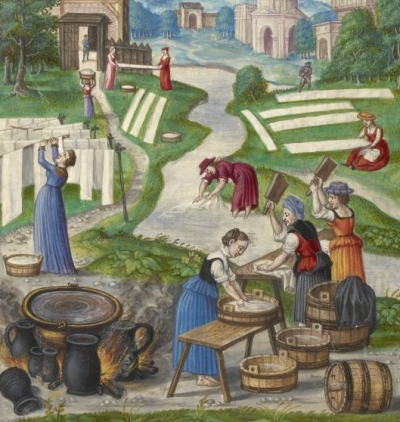
Once upon a time a metal washboard and bar of hard soap with a tub of hot water was a new-fangled way of tackling laundry, though today it's a common picture of "old-fashioned" laundering. (Read about this on a page about the later history of laundry in the 1800s.) What went before? How did people wash clothes without the factory-made equipment and cleansing products of the 19th century?
This page is an introduction to the history of washing and drying household linen and clothing over several centuries: from medieval times up until the 19th century. It concerns Europe, North America, and the English-speaking world more than anywhere else. It's not only an overview; it's also a guide to the other laundry history pages on this website. The links take you to more detailed information and more pictures. Along the way you'll find answers to questions that OldandInteresting gets asked a lot - like, "Is it true people used to wash their clothes in urine?".
Rivers, rocks, washing bats, boards
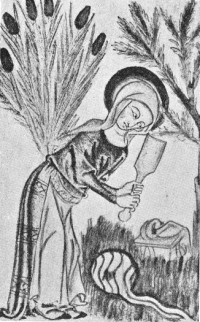
Washing clothes in the river is still the normal way of doing laundry in many less-developed parts of the world. Even in prosperous parts of the world riverside washing went on well into the 19th century, or longer in rural areas - even when the river was frozen. Stains might be treated at home before being taken to the river. You could take special tools with you to the river to help the work: like a washing bat or a board to scrub on. Washing bats and beetles were also useful for laundering elsewhere, and have been used for centuries, sometimes for smoothing dry cloth too. (See 14th century picture left and 16th century painting above.)
Long thin washing bats are not very different from sticks. Both can be used for moving cloth around as well as for beating the dirt out of it. Doing this with a piece of wood was called possing, and various styles of possers, washing dollies etc. developed as an improvement on plain tree branches. Squarish washing bats could double up as a scrub board. Simple wooden boards can be taken to the riverside, or rocks at the edge of the water may be used as scrubbing surfaces. (The more sophisticated kind of wash board with ridged metal in a wooden frame came later.) Two other techniques for shifting dirt are slapping clothes or trampling with bare feet. (See below left.)
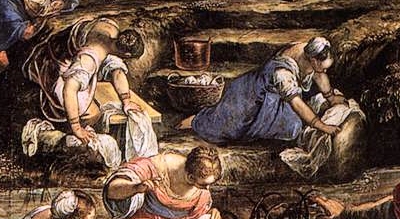
Domestic laundry was often treated like newly woven textiles being "finished". Today we have only vague ideas about how the fabrics in our shop-bought clothes are manufactured, but traditional laundry methods often followed techniques used by weavers, including home weavers.
Lye, bucking, soaking
Soaking laundry in lye, cold or hot, was an important way of tackling white and off-white cloth. It was called bucking, and aimed to whiten as well as cleanse. Coloured fabrics were less usual than today, especially for basic items like sheets and shirts. Ashes and urine were the most important substances for mixing a good "lye". As well as helping to remove stains and encourage a white colour, these act as good de-greasing agents.
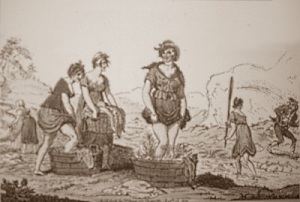
Bucking involved lengthy soaking and was not a weekly wash. Until the idea of a once-a-week wash developed, people tended to have a big laundry session at intervals of several weeks or even months. Many women had agricultural and food preparation duties that would make it impossible for them to "waste" time on hours of laundry work every week. If you were rich you had lots of household linen, shirts, underclothing etc. and stored up the dirty stuff for future washing. If you were poor your things just didn't get washed very often. Fine clothing, lace collars and so on were laundered separately.
Soap, mainly soft soap made from ash lye and animal fat, was used by washerwomen whose employers paid for it. Soap was rarely used by the poorest people in medieval times but by the 18th century soap was fairly widespread: sometimes kept for finer clothing and for tackling stains, not used for the whole wash. Starch and bluing were available for better quality linen and clothing. A visitor to England just before 1700 sounded a little surprised at how much soap was used in London:
At London, and in all other Parts of the Country where they do not burn Wood, they do not make Lye. All their Linnen, coarse and fine, is wash'd with Soap. When you are in a Place where the Linnen can be rinc'd in any large Water, the Stink of the black Soap is almost all clear'd away.
M. Misson's Memoirs and Observations in his Travels over England (first published in French, 1698)
Drying, bleaching
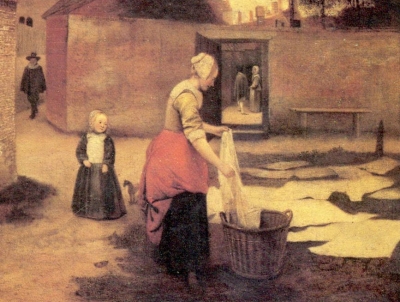
The Grand Wash or the Great Wash were names for the irregular "spring cleaning" of laundry. Soaking in lye and bucking in large wooden bucking tubs were similar to processes used in textile manufacturing. So was the next stage - drying and bleaching clothes and fabrics out of doors. Sunshine helped bleach off-white cloth while drying it. Sometimes cloth was sprinkled at intervals with water and/or a dash of lye to lengthen the process and enhance bleaching.
Towns, mansions, and textile weavers had an area of mown grass set aside as a bleaching ground, or drying green, where household linens and clothing could be spread on grass in the daylight. Early settlers in America established communal bleaching areas like those in European towns and villages. Both washing and drying were often public and/or group activities. In warmer parts of Europe some cities provided communal laundry spaces with a water supply.
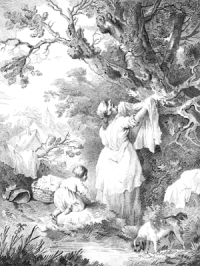
People also dried clothes by spreading them on bushes. Large houses sometimes had wooden frames or ropes for drying indoors in poor weather. Outdoor drying frames and clotheslines are seen in paintings from the 16th century, but most people would have been used to seeing laundry spread to dry on grass, hedgerows etc. Clothes pegs/pins seem to have been rare before the 18th century. Pictures show sheets etc. hung over clotheslines with no pegs.
Richmond, Virginia in the 1770s:
Customers took their laundry to washerwomen's homes and returned there to collect clean clothes.... ...Much washing took place in public. ... washerwomen "boyle[d]...the cloaths with soap" ... Laundresses then gathered near the market house where Shockoe Creek approached the James River. They "washed in the stream" and then allowed clothes to dry on a nearby pasture...
James Sidbury, Ploughshares into Swords: Race, Rebellion, and Identity in Gabriel's Virginia, 1730-1810
Quotes and info from Journal of John Harrower: An Indentured Servant in the Colony of Virginia 1773 1776
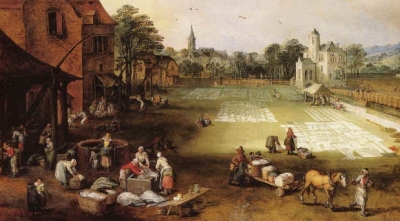
Excellent post! I must thank you for this informative read. I hope you will post again soon.
ReplyDeleteKind regard
Laundry Business In India